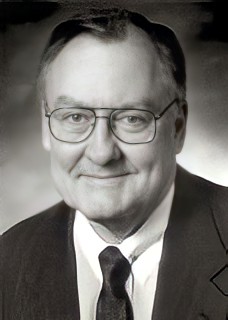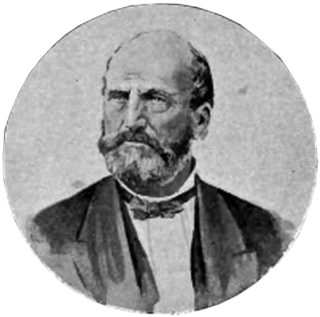
James Robert Thompson Jr., also known as Big Jim Thompson, was the 37th and longest-serving governor of the US state of Illinois, serving from 1977 to 1991. A Republican, Thompson was elected to four consecutive terms and held the office for 14 years. Many years after leaving public office, he served as a member of the National Commission on Terrorist Attacks Upon the United States.

The Illinois General Assembly (IGA) is the bicameral legislature of the U.S. state of Illinois and comprises the Illinois House of Representatives and the Illinois Senate. The General Assembly was created by the first state constitution adopted in 1818. The State Senate has 59 members while the House has 118 members, all elected from single-member districts. A Senate district is formed by combining two adjacent House districts. The current General Assembly is Illinois's 100th. The General Assembly meets in the Illinois State Capitol in Springfield, Illinois. Its session laws are generally adopted by majority vote in both houses, and upon gaining the assent of the Governor of Illinois. They are published in the official Laws of Illinois.

The Illinois House of Representatives is the lower house of the Illinois General Assembly, the bicameral legislature of the U.S. state of Illinois. The body was created by the first Illinois Constitution adopted in 1818. The House consists of 118 representatives elected from individual legislative districts for two-year terms with no limits; redistricted every 10 years, based on the 2010 U.S. census each representative represents approximately 108,734 people.

The Illinois gubernatorial election of 2006 occurred on November 7, 2006. The Governor of Illinois, Democrat Rod Blagojevich, won re-election for a four-year term scheduled to have ended on January 10, 2011. However, Blagojevich was impeached and convicted in 2009. Many observers expected the race to be close, especially considering the polling, which has shown Governor Blagojevich had a high disapproval rating. However, the Republicans had fared poorly in elections since 2002 due to scandals involving prior Governor George Ryan, and the increasingly unpopular presidency of George W. Bush.

The Lieutenant Governor of Illinois is the second highest executive of the State of Illinois. In Illinois, the lieutenant governor and governor run on a joint ticket, and are directly elected by popular vote. Candidates for lieutenant governor ran separately in the primary from candidates for governor until 2014, when the system was changed to allow the gubernatorial nominee of a party to select the nominee for lieutenant governor. When the Governor of Illinois becomes unable to discharge the duties of that office, the lieutenant governor becomes acting governor. If the Governor dies, resigns or is removed from office, the lieutenant governor becomes governor. Under the Illinois Constitution, the Attorney General is next in line of succession to the Governor's office after the lieutenant governor, but does not succeed to the Lieutenant Governor's office. From the impeachment of Rod Blagojevich in 2009 until the inauguration of Sheila Simon in 2011, Attorney General Lisa Madigan would have become Governor if Pat Quinn had vacated the office. Historically, the lieutenant governor has been from either the Democratic Party or Republican Party. The current lieutenant governor is Democrat Juliana Stratton.

Patrick Joseph Quinn Jr. is an American lawyer and politician who served as the 41st Governor of Illinois, from 2009 to 2015. A Democrat, Quinn began his career as an activist by founding the Coalition for Political Honesty. He is currently working on Take Charge Chicago, a petition for referendums to limit the Mayor of Chicago to two four-year terms and create an elected Consumer Advocate in the city.
The 2006 Election for statewide offices in the State of Illinois were held on 7 November 2006. On that date, registered voters in the State of Illinois were eligible to elect officeholders in six statewide offices: the office of Governor of Illinois, Lieutenant Governor of Illinois, Illinois Attorney General, Illinois Secretary of State, Illinois Treasurer and Illinois Comptroller.
The US state of Illinois is a Democratic stronghold and one of the "big three" Democratic states alongside California and New York. It is considered one of the most Democratic states in the nation and following the 2018 elections, all six statewide elected offices are held by a Democrat.
Illinois is a Democratic stronghold in presidential elections and one of the three largest Democratic states in the nation alongside California and New York. It is one of the most Democratic states in the nation with all state executive offices and both state legislative branches held by Democrats. For most of its history, Illinois was widely considered to be a swing state, voting for the winner of all but two presidential elections in the 20th century. Political party strength in Illinois is highly dependent upon Cook County, and the state's reputation as a blue state rests upon the fact that the majority of its population and political power is concentrated in Chicago, Cook County, and the Chicago metropolitan area. Outside of Chicago, the suburban collar counties continue trending Democratic while downstate Illinois can be considered more conservative with some moderate regions.

The 2010 Illinois gubernatorial election took place on November 2, 2010. Incumbent Democratic Governor Pat Quinn sought and was elected to a full term in office. Quinn was elected as the Democratic nominee, the Illinois Green Party nominee was attorney and 2006 nominee Rich Whitney, the Republican nominee was State Senator Bill Brady, the Libertarian Party nominee was Lex Green, and Scott Lee Cohen ran as an independent. Governor Quinn won election to a full term in a very close race, beating Senator Brady by only about 32,000 votes, despite Brady winning in 98 of 102 Illinois counties.

The Illinois gubernatorial election of 1826 was the third quadrennial election for this office. former Territorial Governor Ninian Edwards was elected with a 49% plurality. State senator Thomas Sloo, Jr. came in second and Former Lieutenant Governor Adolphus Hubbard came in third.

The Illinois gubernatorial election of 1834 was the fifth quadrennial election for this office. U.S. Representative Joseph Duncan was elected by a majority of the voters. He defeated former Lt. Governor William Kinney and former state treasurer Robert K. McLaughlin. Kinney had run in the election before as well. This was the only election of a Whig Governor in Illinois history.

The Illinois gubernatorial election of 1848 was the ninth election for this office. Democratic governor Augustus C. French was easily re-elected. This was the first gubernatorial election in Illinois that was held on the same date as the United States presidential election.

The Illinois gubernatorial election of 1856 was the eleventh election for this office. Democratic governor Joel Aldrich Matteson did not seek re-election. Former Democratic Congressman William Henry Bissell was nominated by the newly formed Republican Party at the Bloomington Convention. Former Whig Mayor of Chicago Buckner S. Morris was nominated on the Know-Nothing Party ticket. This was the first election of a Republican governor in Illinois history. At this time in Illinois history the Lieutenant Governor was elected on a separate ballot from the governor. This would remain the case until the adoption of the 1970 constitution.

The Illinois gubernatorial election of 1860 was the twelfth election for this office. Republican governor William Henry Bissell died early in his term, and incumbern governor John Wood did not seek re-election. Former Democratic Congressman and former Clerk of the U.S. House James C. Allen was the Democratic nominee. A Number of third-party candidates ran as well; none received over one percent of the vote. At this time in Illinois history the Lieutenant Governor was elected on a separate ballot from the governor. This would remain the case until the adoption of the 1970 constitution.

The 2014 United States Senate election in Illinois took place on November 4, 2014, to elect a member of the United States Senate to represent the State of Illinois, concurrently with the election of the Governor of Illinois, as well as other elections to the United States Senate in other states and elections to the United States House of Representatives and various state and local elections.

The Illinois gubernatorial election of 1864 was the thirteenth election for this office and took place during the American Civil War. Republican governor Richard Yates did not run for re-election, but was instead elected to serve in the United States Senate. Major General Richard J. Oglesby resigned his commission to run as the Republican nominee. Congressman James Carroll Robinson was the Democratic nominee. At this time in Illinois history the Lieutenant Governor was elected on a separate ballot from the governor. This would remain the case until the adoption of the 1970 constitution.

The Illinois gubernatorial election of 1872 was the fifteenth election for this office. Republican nonimee, Former Governor Richard J. Oglesby defeated the Democratic and Liberal Republican nominee Gustavus Koerner. B. G. Wells represented Independent Democrats unwilling to ally with Liberal Republicans. Oglesby had agreed to run for the Governorship but to resign upon being elected so that Lt. Governor John Lourie Beveridge could assume the office. Oglesby was in turn appointed to the U.S. Senate.














